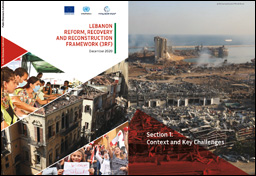Friday 4 December 2020
An 18-Month Framework in Response to Beirut Port Explosion
Keywords: EU, Lebanon, UN, World Bank
BEIRUT (World Bank press service) — Four months after the tragic August 4 explosion that rocked the Port of Beirut, the European Union (EU), the United Nations (UN) and the World Bank Group (WBG) launched today, in a virtual press conference, a landmark “people-cantered” response plan to help Lebanon address the urgent needs of the affected population as well as tackle the related governance, recovery and reconstruction challenges.
The 18-month Lebanon Reform, Recovery and Reconstruction Framework (3RF) addresses the urgent needs of the population affected by the explosion that killed over 200 people, injured more than 6,500 and destroyed thousands of homes and properties in the capital city. This comprehensive response to the explosion bridges the immediate humanitarian assistance with medium-term recovery and reconstruction efforts, in order to put Lebanon on a path of sustainable development. It is also guided by the overarching principles of transparency, accountability, and inclusion.
The 3RF aims to achieve three central goals:
- A people-cantered recovery that addresses people’s basic needs, restores their livelihoods, improves social justice for all and ensures participatory decision-making;
- the reconstruction of critical assets, services, and infrastructure that provides equal access to quality basic services for all and enables sustainable economic recovery;
- the implementation of reforms as an essential requirement to restore trust, support reconstruction and improve governance.
Speaking at the conference held at the UN House in Beirut were the Ambassador of the European Union to Lebanon, Ralph Tarraf, the UN Deputy Special Coordinator, Resident and Humanitarian Coordinator for Lebanon, Najat Rochdi, and the Regional Director of the Middle East Department of the World Bank, Saroj Kumar Jha.
Rochdi said that “the 3RF is fundamentally for the people, it is about meeting their critical needs, safeguarding their basic rights, giving them a voice and a place in policy making”. That is why it adopted a participatory and inclusive approach that involved all key stakeholder groups, including civil society, from planning through implementation, she added. “The 3RF provides a vision for Building Back Better, a plan to prevent a full-scale humanitarian catastrophe.”
Tarraf underscored that re-gaining the trust of the Lebanese people in state institutions is imperative for a successful recovery and reconstruction. To that end, the government needs to assume responsibility and urgently adopt credible structural reforms, he said. “Lebanon needs a new governance model that ensures that state institutions serve people’s needs and addresses the multiple crises the country faces”, he added.
The 3RF pursues two parallel tracks:
- A socio-economic recovery track (“track 1”), that addresses the urgent needs of the most vulnerable populations and small businesses affected by the explosion;
- A reform and reconstruction track (“track 2”), focusing on critical reforms to address governance and recovery challenges in Lebanon, which are prerequisites for mobilizing international support for reconstruction beyond the recovery track.
“Channelling support directly to Lebanese people and businesses that have been impacted by the explosion is of utmost importance. To that effect, a Lebanon Financing Facility (LFF) will be set up to receive grant financing from donors for the implementation of the 3RF”, said Saroj Kumar Jha. “The LFF will focus on immediate recovery needs of poor and vulnerable households, support business recovery programs, promote inclusive ways of working with civil society and prepare the ground for reform and reconstruction. It will adopt flexible, non-governmental implementation modalities combined with strong fiduciary monitoring and independent oversight over the use of LFF funds”, he added.
With people at the heart of this response plan, the framework is structured around four strategic pillars: i) improving governance and accountability, ii) jobs and economic opportunities, iii) social protection, inclusion and culture, and iv) improving services and infrastructure. Each pillar identifies strategic objectives and priority areas across both the recovery and the reform and reconstruction tracks.


